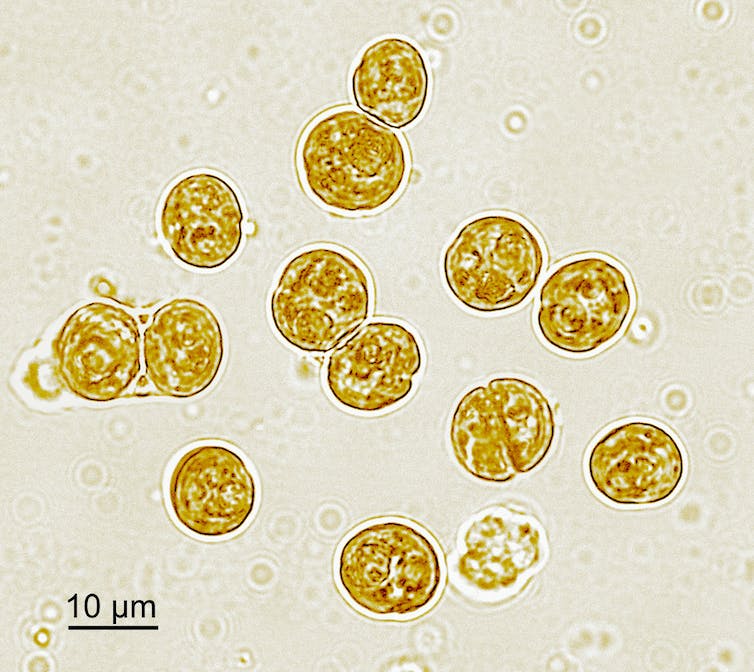Coral reefs thrive in parts of the world’s oceans that are low in nutrients. This mystery has puzzled scientists for centuries and has become known as the “Darwin paradox of coral reefs”.
Our new study adds the missing piece of the puzzle. We found that many species of coral cultivate and feed on the microscopic algae that live inside their cells. This vegetarian diet allows the corals to tap into a large pool of nutrients that was previously considered unavailable to them.
Stony corals are soft-bodied animals made up of many individual polyps that live together as a colony. They secrete limestone skeletons that form the foundation of reefs. The coral polyps acquire nutritious compounds rich in nitrogen and phosphorus by catching prey like zooplankton with their tentacles.
Many coral animals are also dependent on a symbiosis – a mutually beneficial relationship – with the microscopic algae that live inside their cells. These photosynthetic algae produce large amounts of carbon-rich compounds, such as sugars, and transfer them to the host coral to generate energy. However, as most photosynthetic products are deficient in nitrogen and phosphorous, they cannot sustain the growth of the animals.
Our findings suggest that, while coral animals may survive brief periods of starvation by feeding on their symbionts, some coral reefs could face the risk of prolonged nutrient deficiency due to global warming. This is concerning. Coral reefs are important underwater ecosystems that provide a home and feeding ground for countless organisms, sustaining around 25% of the world’s ocean biodiversity.
J. Wiedenmann & C. D’Angelo/University of Southampton, CC BY-NC-ND
Vegetarian diet
The symbiotic algae living within the corals are very efficient at taking up dissolved inorganic nutrients, like nitrate and phosphate, from the surrounding seawater. Even in nutrient-poor areas of the ocean, these compounds are present in considerable amounts as excretion products of organisms, such as sponges, that live close by. Ocean currents can also transport these nutrients to reefs.
The coral host, on the other hand, cannot absorb or use nitrate and phosphate directly. But, through a series of long-term laboratory experiments, we demonstrated that corals actually digest some of their symbiont population to access the nitrogen and phosphorus that these algae absorb from the water.
To provide evidence that the nutrients accumulated by the growing coral tissue originated from the symbionts, we supplied the corals with a chemical form of nitrogen that can only be absorbed from the water by the symbionts, not by the coral host.
This nutrient compound was marked by a technique called isotopic labelling, which uses nitrogen atoms that are heavier than normal. These “heavy” isotopes allowed us to track the movement of nitrogen between the partners of the symbiosis by ultrasensitive detection methods.
With this method, we could unambiguously demonstrate that the nitrogen atoms that sustained the growth of the coral tissue were derived from the dissolved inorganic nutrients that were fed to their symbiont algae.
Our data suggest that most species of symbiotic corals can supplement their nutrition through such a vegetarian diet.
From the laboratory to the ocean
Together with our colleagues, we also analysed corals growing around remote islands in the Indian Ocean, some with seabirds on them and some without. Our results show that corals have the potential to farm and feed on their symbiont algae in the wild too.
The reefs around some of these islands are supplied with substantial amounts of nutrients that come from “guano” – the excrement of seabirds nesting on the islands. On some of the other islands, seabird colonies have been decimated by invasive rats. The reefs surrounding these islands receive fewer nutrients.
Invasive rats are changing fish behaviour on coral reefs – new study
We measured the growth of staghorn coral colonies both around islands with and without dense seabird populations and found that growth was more than twice as fast on reefs that were supplied with seabird nutrients. About half of the nitrogen molecules in the tissue of the coral animals from islands with seabirds could be traced back to uptake by the symbiont algae.
N. Graham/Lancaster University, CC BY-NC-ND
Global warming could complicate matters
In the future, some coral reefs could face a decrease in nutrient availability due to global warming. Research suggests that warming surface waters are less likely to receive nutrients from deeper water layers. The reduced water productivity could result in fewer nutrients for their symbionts and subsequently less food for the coral animals.
Our study indicates that some coral reefs might become vulnerable to starvation as ocean temperatures warm. When we moved corals from water with ample nutrients to water with fewer nutrients, they continued to eat their symbiont algae. This behaviour allowed them to sustain their growth for a few weeks, even in the absence of feeding.
But once they had exhausted their population of symbiotic algae, the coral underwent bleaching (referring to the white appearance of the corals with low symbiont numbers in their tissue), stopped growing – and in some cases eventually died.
L. Mardones-Velozo, C. D’Angelo & J. Wiedenmann, University of Southampton, CC BY-NC-ND
Our findings reveal that corals can not only acquire nitrogen and phosphorus by feeding on prey as other animals do. But, by eating parts of their symbiont stock, they can also efficiently tap into the pool of dissolved inorganic nitrogen and phosphorus that is otherwise only accessible to plants.
Through this process, symbiotic corals gain an advantage over other animals in environments that are low in nutrients, explaining their prominent role in the formation of reefs in nutrient-poor water.
However, increasingly severe nutrient depletion will add a further threat to some coral reefs already experiencing bleaching caused by heat stress.

